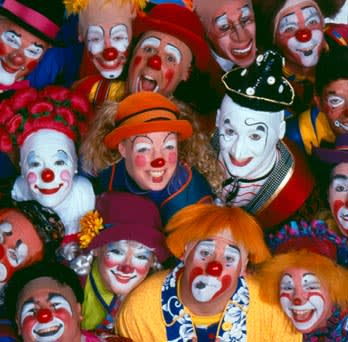simchathalev200.jpg)
Clowns are not just for circuses, birthday parties, street fairs and Purim parties. Medical clowns are people who, for the most part, visit patients in hospitals. They are trained to help the patients laugh in order to help them heal.
According to researchers, children laugh about 500 times a day and the average adult laughs only 15 times a day. Studies on laughter have shown that laughing increases endorphins (natural painkillers), increases memory retention and creativity, lessens pain from chronic diseases, can relieve allergy and arthritic symptoms, and strengthens the immune system.
Dr. Hunter (“Patch”) Adams, a doctor from West Virginia, thinks that humor is a better healer than any drug. He founded the Virginia based Adam’s Gesundheit Institute in 1972 in order to give quality and empathic medical care to those in need. He organizes clown trips to hospitals around the world. The 1998 film “Patch Adams” told the real-life story of Dr. Adams, who believes that humor and humanity need to play a major role in patient care.
In 2006 the University of Haifa opened a new program for medical clowns, the first of its kind in Israel. The medical clowns are studying for a BA degree in theater and participate in specially designed courses in nursing. According to Dr. Ati Citron, head of the Department of Theater at the University of Haifa, “The program teaches medical clowns things you don’t learn in acting school like the relationship between caregiver and patient or the psychological state of a patient in pain.”
Herzl Tziony, a student in the new program said, “Clowning enables the opening of avenues of communication with patients that the medical staff doesn’t succeed with or doesn’t know how to connect with. When a clown arrives, he uses skills that open up gates, cross boundaries, and reach places that most people don’t allow themselves to go to in a hospital setting. Clowning engages in different areas than any other paramedical field. We reach other places, create experiences. We create distraction, so the patient won’t feel his pain and can fly with us to fantasy lands. This is actually a type of therapy—clown therapy.”
Clown therapy is a unique way to treat patients and speed their recovery. For example, children with serious burns are afraid to move because of the pain, but they forget the pain when they reach for bubbles wafting into the air. Patients who are bed-bound can obtain a cardiovascular workout by laughing, which results in rapid muscular contractions and deep, diaphragmatic breathing. One volunteer described how a child needed to learn to do deep breathing in order to relax before procedures. The child refused to do deep breathing, and so a medical clown was called in. He asked the child to help him blow up balloons!
Not even five years old, Simchat HaLev ( happiness of the heart) Organization, a non-profit organization that trains and sends medical clown volunteers to visit patients in Israeli hospitals, has made great inroads into the medical world. Its founder, Tzvi Meir said that he was very determined to start a medical clown program in Israel because “mitzvah gedola leheyot be’simcha” (it is a big mitzvah to be joyful), and he thought hospitals needed a little simcha.
Simchat HaLev educational director Jeff Gordon explained, “Clowning is something that has always touched people. Medical clowning helps them connect with their own strengths and joy and optimism. It assists them in getting over the trauma of the hospital experience.”
Doctors who were once skeptical about having a clown in the ward sometimes ask the medical clown to help them build a relationship with a frightened or stubborn patient or to help the child agree to take medication or cooperate during medical tests. The afternoon that my husband Abe followed medical clown Shakshooka around on his “rounds” in Sharei Tzedek Hospital in Jerusalem, there was a young man who refused to have an IV line inserted. Shakshooka came to the rescue, pot on his head and all, and entertained the young man with all sorts of magic tricks and other acts. The patient was so engrossed in Shakshooka’s show that the IV line was successfully inserted. “Volunteering in the hospital is the highlight of my week!” Shakshooka told me.
Presently Simchat HaLev has 80 medical clowns volunteering in hospitals, homes for the elderly and in nurseries for children with autism. The programs require funding, such as for the clown training. $10,000 is needed each year just for balloons! The organization needs a Joy Mobile to help transport clowns and equipment. To learn more visit www.simchat-halev.org.il
In Israel, tax deductible shekel and dollar checks can be sent to Simchat HaLev–The Association for Medical Clowns, Sderot Volcani 9998, Rechovot. In the US, checks should be made out to Central Fund of Israel and sent to Central Fund of Israel, c/o Marcus Brothers, 980 6th Ave., New York, New York, 10018. Earmark the check for Simchat HaLev.
Sources:
- University of Haifa
- Voices, “Laughter is the Best Medicine,” April 2006
The words of this author reflect his/her own opinions and do not necessarily represent the official position of the Orthodox Union.



